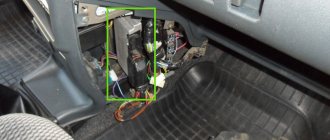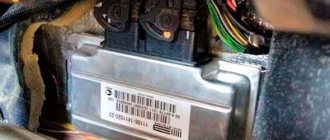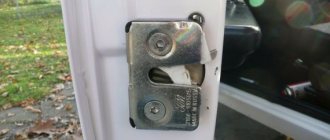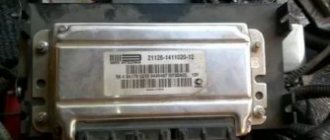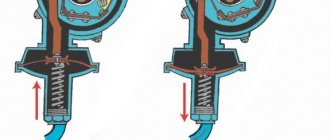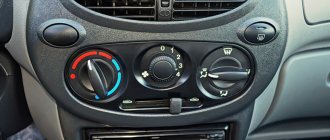The electronic engine control unit of the VAZ 2114 is a unique device that can be described as the brain of a car. Absolutely everything in the car works through this unit - from a small sensor to the engine. And if the device starts to malfunction, then the machine will simply stop, because there is no one to command it, distribute the work of departments, and so on.
To avoid confusion, let’s immediately clarify: the electronic control system, the engines, or brains, the controller, as well as the firmware, the abbreviation ECU and ECM, the processor in the car - all this is the same thing!
To find out where the ECU is located on a VAZ 2114, you need to look under the dashboard dashboard (center), naturally, having first removed all the fastenings of the dashboard casing (if you are interested in looking at the electronic unit right now, a Phillips screwdriver will help you).
But it will be useless for you to look at the location of the block if you do not know what an ECU is and how it works. The principle of operation of the firmware on the fourteenth is not such a complicated process, on the one hand, on the other hand, it brings together the entire system of the engine, suspension, and gearbox. But it is more tied to the engine. From the moment you start your car, the brain of your car begins work on collecting information that comes from all the sensors that are on the fourteenth, then it processes it and distributes the work of the engine system according to the information received.
The ECU on the VAZ 2114 collects data from the following sensors:
- Crankshaft positions
- Phases
- Mass air flow
- Cooling temperatures
- Throttle positions
- Detonation
- Oxygen
- Speeds
This is the main list; there may be tuning gadgets or a couple of other sensors (depending on the configuration), but all of them will always work directly with the VAZ 2114 ECU. Using this information, the controller regulates the operation of the following systems:
- Fuel supply system - everything related to the operation of the fuel pump, pressure and injectors
- Ignition
- Adsorber
- Engines idling
- Radiator operation
- Self-diagnosis
The brains on the VAZ 2114, in order to keep up with everything, consist of three types of memory:
- A department with permanent memory that can be programmed (PROM - program read-only memory). This is what we call firmware; the main program for the operation of the electronic unit can be uploaded to this section. The program contains the basis: calibrations and algorithms for controlling the engine. The advantage of this memory section is that it is permanent and will not be erased during a sudden power cut. Such a moment as chip tuning is associated precisely with this memory.
- A department with RAM, which mainly stores pop-up system errors and those parameter settings that may change depending on the situation (RAM - random access memory). If you turn off the power, everything that was recorded by this memory section will be lost.
- Memory department with anti-theft codes (ERPZU - electrically reprogrammable memory device). This section contains information about the passwords for the signaling system, which the immobilizer checks against each time the engine is started.
ECU January 5.1 and January 7.2 comparison and features - detailed analysis.
I, too, at one time, automatically identified January - and there were glitches, then I turned on manual mode and installed BOSCH 7. Review of each family of ecu January 5.1 and January 7.2. Features of each ecu family, comparison and interchangeability. The blocks being considered are: January 7.2 2111-1411020-82 21114-1411020-32 21124-1411020-32 21067-1411020-11 11183-1411020-21 January 5.1 2112-1411020-41 211 1-1411020-71 2111-1411020-61 2112-1411020 -71 2104-1411020-01 The main difference between January 5.1 and January 7.2 is the treatment of the detonation channel. On 5.1, due to the presence of the HIP9010 processing processor, the channel is hardware, on 7.2 there is no processor, the channel is software. ECU January 5.1 detects detonation better than 7.2. In addition, January 7.2 can control the starter. The difference between the computers of each family January 5.1 and January 7.2 lies in the firmware designed individually for each engine model and the configuration of sensors. For example, in January 5.1.3 there is no knock sensor and phase sensor, in January 5.1-41 they are present.
January-4, GM-09
Since the production of the fourteenth took place over several years, the modernization also affected the properties of the controller. Therefore, the ECU on the VAZ 2114 comes in several types.
One of the very first electronic units was “January 4” and “GM 09”. They were installed on the first Samara 2, starting in 2000. The modification included the presence or absence of a resonant knock sensor.
The model range is quite wide; below are brain versions with toxicity rates and main characteristics.
January-4, GM – 09
Program for computer diagnostics of VAZ.
As I did, with a digital camera, we set it to macro photography, raise the flash and put our hand with the camera on the computer and take a photo, everything is clearly visible, even the dust. KKl VAG adapter for computer diagnostics: Order and do the diagnostics yourself! Another program for home diagnostics of injection cars using a KKL adapter and laptop. The functionality of this program reminded me of working with the Scanmatic scanner. Great opportunities for diagnosing various parameters of injectors. It is possible to create your own sets of parameters, which is very convenient when diagnosing various sensors. You can create a diagnostic kit for, for example, an oxygen sensor and include the necessary parameters to test it. The program also has auto-detection of the ECU, which makes life very easy when you don’t know what kind of unit is in the car.
PRINCIPLE OF OPERATION AND LOCATION OF THE DEVICE
The electronic engine control unit starts working when the ignition is activated; it continuously functions while driving, collecting information from various fourteenth sensors. The received information is analyzed by the processor and, based on the results of the analysis of the received data, the device controls the functional systems of the VAZ-2114.
The VAZ 2114 engine control unit receives information from the following fourteenth sensors:
- (sensor) speed of movement;
- Oxygen;
- Detonation;
- Fuel injection phases;
- Crankshaft position;
- Throttle position;
- Instant air flow;
- Liquid temperatures in the cooling system.
Based on the information received, the ECU on the VAZ 2114 controls the following systems and components of the vehicle:
- Adsorber;
- Ignition system;
- Injectors and fuel pump;
- Ventilation;
- Automatic diagnostic programs;
- Idle speed control unit.
The brains on the VAZ 2114 consist of 3 separate devices, each of which has an individual type of memory:
- Random access memory device - a RAM unit is a system that has short-term memory. RAM contains information about recent errors that the ECU detected in the fourteenth systems and various current vehicle parameters. The RAM memory is completely updated when the ignition is turned off.
- A programmable permanent storage device is the main memory unit; it stores the ECU firmware. The PROM contains information about the results of calibrations of the fourteenth systems, as well as the power unit control algorithm. The EPROM memory is permanent; it is stored when the ignition is turned off. With certain skills, the EPROM block can be reprogrammed, which will improve the power and dynamics of the VAZ 2114.
- An electrically reprogrammable storage device - the main functional purpose of the unit is to protect the machine. The EEPROM contains data from the fourteenth anti-theft system - passwords and their encoding. It will be possible to start the engine only after the EPROM and the immobilizer compare data with each other.
The VAZ 2114 ECU is hidden inside the dashboard, right under the dashboard. In order to get to the brains, you need to use a Phillips screwdriver to unscrew the fixing screws and remove the side panel of the dashboard from the passenger seat. There you will see a longitudinal plastic brain housing, which is inserted inside a stainless steel retainer.
To remove the control unit, you need to unscrew the fixing bolt and pull the lock towards you, after which the device can be freely removed (you must first completely de-energize the car by removing all terminals from the battery).
You remove the panel, and behind it the “brains” - everything is simple!
Electronic engine control units January
Electronic control units for injection engines (ECUs, controllers) January VAZ cars have been produced since the late 90s of the last century. The ECMs of most VAZ car models, both front-wheel drive and rear-wheel drive, worked and operate under their control. Below is a table of the applicability of the main ECM control units for injection engines of VAZ cars of various years of production (from the 90s to the present day). With toxicity standards R-83, EURO-2, 3, 4. The features of the ECM in which they are installed are also listed.
Controllers (ECU) January
January-4.1 (4)
Software ID: J4V13O14, J4V13V14, J4V13N14, J4V13T14.
Engine: 8 valve 2111, 1.5 liters (VAZ cars 21083, 21093, 21099, 21102).
Features of the ECM: without neutralizer, oxygen sensor (lambda probe), with CO potentiometer (manual CO adjustment), toxicity standard R-83.
January 4.1
Software ID: J4V07W15, J4V07Y16, J4V07Y19.
Engine: 16 valve 2112, 1.5 liters (VAZ 21103).
Features of the ECM: without neutralizer, oxygen sensor (lambda probe), with CO potentiometer (manual CO adjustment), R-83.
January 5.1
Software ID: J5V03F21, J5V03G21, J5V03H21, J5V03I21, J5V03J21, J5V03K21, J5V03L21.
Engine: 8 valve 2111, 1.5 liters (VAZ cars 21083, 21093, 21099, 21102, 21110).
Features of the ECM: neutralizer, adsorber, oxygen sensor, Euro-2.
January 5.1
Software ID: J5V05F16, J5V05H16, J5V05I16, J5V05J16, J5V05K17, J5V05L19, J5V05M30, J5V05N35, 5V05N35.
Engine: 16 valve 2112, 1.5 liters (VAZ cars 21103, 21113, 2112).
Features of the ECM: neutralizer, adsorber, oxygen sensor, Euro-2.
January 5.1.1
Software ID: J5V13F02, J5V13H02, J5V13I02, J5V05J16, J5V13L05, 5V13L05.
Engine: 8 valve 2111, 1.5 liters (VAZ cars 21083, 21093, 21099, 21102, 21110).
Features of the ECM: without neutralizer, oxygen sensor (lambda probe), with CO potentiometer (electronic CO adjustment, R-83).
January 5.1.2
Software ID: J5V07G26, J5V07I27, J5V07J28.
Engine: 16 valve 2112, 1.5 liters (VAZ cars 21103, 21113, 2112).
Features of the ECM: without neutralizer, oxygen sensor (lambda probe), with CO potentiometer (electronic CO adjustment, R-83).
January 5.1.3
Software ID: J5V26K23, J5V05L52.
Engine: 8 valve 2107, 1.5 liters (VAZ cars 2106-20, 21043-20, 21061-20, 2107-20).
Features of the ECM: neutralizer, adsorber, oxygen sensor, no knock sensor, Euro-2.
January 7.2
Manufactured by Avtel, software ID A203EK34.
Engine: 8 valve, 2111, volume 1.5 liters (VAZ cars 2113, 2114, 2115).
Features of the ECM: neutralizer, adsorber, one oxygen sensor, Euro-2.
January 7.2
Manufactured by Itelma, software identifier I203EK34, software I203EL35.
Engine: 8 valve, 2111, volume 1.5 liters (VAZ cars 2113, 2114, 2115).
Features of the ECM: neutralizer, adsorber, one oxygen sensor, Euro-2.
January 7.2
Manufactured by Itelma, software identifier I204DM52, software I204DM53.
Engine: 8 valve, 21114, volume 1.6 liters (VAZ cars 2113, 2114, 2115, 21101, 21112, 21121, Lada Kalina, Lada Granta).
Features of the ECM: neutralizer, adsorber, oxygen sensor, Euro-2.
January 7.2
Manufactured by Itelma, software identifier I205DM52, software I205DM53, I205DP57.
Engine: 16 valve, 21124, volume 1.6 liters (VAZ cars 21104, 21114, 21123, 21124).
Features of the ECM: neutralizer, adsorber, oxygen sensor, Euro-2.
January 7.2
Manufactured by Avtel, Itelma, software identifier A226FM10, software I226FM10.
Engine: 8 valve, 21067, 1.6 liter (VAZ 21074-20).
Features of the ECM: neutralizer, adsorber, oxygen sensor, no phase and knock sensors, Euro-2.
Notes and additions
— The ECU is a specialized microcomputer in which the engine control program is installed, and sensors and actuators are the peripheral equipment of this computer. Based on the received data, the block calculates control commands and issues them to actuators.
Source
ECU diagnostics
The VAZ engine control unit is a device that can operate for a long time without breakdowns, however, no equipment can be protected from malfunctions. When the first symptoms of failure are detected, the device must be diagnosed, since untimely inspection and repair can lead to more serious consequences. Device diagnostics involves reading error codes stored in the device’s memory for further decryption.
It is best to check the ECU in specialized centers, since the diagnostic equipment must be configured for a specific ECU model. Of course, the diagnostic procedure can be carried out on your own - using a computer, diagnostic adapter and software.
In the event that the ECU does not respond to the test, its performance should be checked, in particular:
- diagnose the device for overheating;
- make sure that the device is connected to the power circuit and that its contact with the on-board network is good;
- diagnose the mechanical integrity of the device - it is quite possible that there is damage to the device body, or the reason may be the formation of corrosion.
Remember that it is impossible to perform high-quality repairs of the control unit at home . It is better to entrust the repair procedure to specialists, and not from any service station, but from certified centers.
Photo gallery “Do-it-yourself ECU replacement”
Stories from our readers
“Fucking basin. "
Hi all! My name is Mikhail, now I’ll tell you a story about how I managed to exchange my two-wheeler for a 2010 Camry. It all started with the fact that I began to be wildly irritated by the breakdowns of the two-wheeler, it seemed like nothing serious was broken, but damn it, there were so many little things that really started to irritate me. This is where the idea arose that it was time to change the car to a foreign car. The choice fell on the melting Camry of the tenth years.
In December 2005, NPP Avtel released for spare parts (this was never supplied to the VAZ assembly line.) ECU “January 5.1.x” with modified hardware.
The next step in the fight for environmental friendliness of exhaust was the development, commissioned by AvtoVAZ OJSC, of a more modern unit that could meet more stringent toxicity and diagnostic standards Euro-2 and Euro-3, called MP7.0. In this modification, both the hardware and software were developed, the final calibration and fine-tuning of the systems was carried out by AvtoVAZ OJSC.
This family is also expanding and has already been supplemented with systems meeting Euro-3 standards for 8 and 16-valve engines of front-wheel drive vehicles, as well as for all-wheel drive vehicles VAZ-21214 and VAZ-2123 (Euro-2 and Euro-3 standards).
NPO Itelma has developed an ECU for use in VAZ cars, called VS 5.1. This is a fully functional analogue of the ECM January 5.1, that is, it uses the same harness, sensors and actuators. Modifications 2112-1411020-42 and 2111-1411020-62 are designed for Euro-2 standards and include an oxygen sensor, catalytic converter and adsorber; this family does not provide for P-83 standards for 2112 engines.
For VAZ 2111 and Russia-83 standards, only the ECM version VS 5.1 1411020-72 with simultaneous injection is produced. For “classics” with a volume of 1.45 liters. modification VS5.1 2104-1411020-02 is available, with DC (Euro-II) and without a detonation channel. These ECMs were discontinued in early 2005.
Controllers with software for 16 cells. engines under Euro-3 standards support the function of software switching of starting calibrations Europe/Russia from diagnostic equipment. This function, according to the developers, should make starting on low-quality gasoline easier. Default to .
The first batch of Lada Priora cars, which is a deep restyling of the “tenth” family, began rolling off the VAZ assembly line at the beginning of 2007. And also with a Bosch M7.9.7+ ECU (firmware B173DR01, “homemade” nameplate, pasted on top of the original one).
For the “classics”, ECU 21067-1411020-11(12) was developed for configuration without a knock sensor, with a Siemens-VDO mass air flow sensor. This modification is installed on 1.6-liter engines. And, as usual, the detonation channel elements are not installed in the block.
For this type of ECU, a complete software shutdown of the DC and adjustment of the CO content in the exhaust gases has been implemented, that is, a transfer to Russia-83 toxicity standards.
Where is the VAZ 2114 ECU located?
The block is located in the dashboard, directly under the tidy. To replace or dismantle, you need to unscrew the screws and remove the panel from the side, on the passenger side. Through the resulting hole you can see the ECU housing - it is installed inside a steel retainer.
To remove the electronic control unit, you need to unscrew the bolt and carefully pull out the housing, grasping the latch. Of course, it is necessary to turn off the power from the on-board network, otherwise expensive equipment can be damaged. A short circuit is the enemy of any electrical appliance, so be careful. It is advisable not only to remove ground from the battery, but also to disconnect the positive wire.
What is an ECU (ECM)
Let's first find out the purpose of the engine ECU and determine what kind of device it is and whether it is really needed in the design of modern vehicles.
The ECU directly affects not only the operation of an individual sensor, but also the functioning of the entire vehicle, which makes it difficult to overestimate its role in a modern car.
Along with the already mentioned term “ECU”, the following concepts are often used: “electronic engine control system”, “brains”, “controller” and “firmware”.
Therefore, if you hear such names, then you need to understand that we are talking about the main processor of a particular machine. That is, when you hear about the ECM, ECU or “controller”, you must understand that they are one and the same thing.
Electronic engine control units January
Electronic control units for injection engines (ECUs, controllers) January VAZ cars have been produced since the late 90s of the last century. The ECMs of most VAZ car models, both front-wheel drive and rear-wheel drive, worked and operate under their control. Below is a table of the applicability of the main ECM control units for injection engines of VAZ cars of various years of production (from the 90s to the present day). With toxicity standards R-83, EURO-2, 3, 4. The features of the ECM in which they are installed are also listed.
Controllers (ECU) January
January-4.1 (4)
Software ID: J4V13O14, J4V13V14, J4V13N14, J4V13T14.
Engine: 8 valve 2111, 1.5 liters (VAZ cars 21083, 21093, 21099, 21102).
Features of the ECM: without neutralizer, oxygen sensor (lambda probe), with CO potentiometer (manual CO adjustment), toxicity standard R-83.
January 4.1
Software ID: J4V07W15, J4V07Y16, J4V07Y19.
Engine: 16 valve 2112, 1.5 liters (VAZ 21103).
Features of the ECM: without neutralizer, oxygen sensor (lambda probe), with CO potentiometer (manual CO adjustment), R-83.
January 5.1
Software ID: J5V03F21, J5V03G21, J5V03H21, J5V03I21, J5V03J21, J5V03K21, J5V03L21.
Engine: 8 valve 2111, 1.5 liters (VAZ cars 21083, 21093, 21099, 21102, 21110).
Features of the ECM: neutralizer, adsorber, oxygen sensor, Euro-2.
January 5.1
Software ID: J5V05F16, J5V05H16, J5V05I16, J5V05J16, J5V05K17, J5V05L19, J5V05M30, J5V05N35, 5V05N35.
Engine: 16 valve 2112, 1.5 liters (VAZ cars 21103, 21113, 2112).
Features of the ECM: neutralizer, adsorber, oxygen sensor, Euro-2.
January 5.1.1
Software ID: J5V13F02, J5V13H02, J5V13I02, J5V05J16, J5V13L05, 5V13L05.
Engine: 8 valve 2111, 1.5 liters (VAZ cars 21083, 21093, 21099, 21102, 21110).
Features of the ECM: without neutralizer, oxygen sensor (lambda probe), with CO potentiometer (electronic CO adjustment, R-83).
January 5.1.2
Software ID: J5V07G26, J5V07I27, J5V07J28.
Engine: 16 valve 2112, 1.5 liters (VAZ cars 21103, 21113, 2112).
Features of the ECM: without neutralizer, oxygen sensor (lambda probe), with CO potentiometer (electronic CO adjustment, R-83).
January 5.1.3
Software ID: J5V26K23, J5V05L52.
Engine: 8 valve 2107, 1.5 liters (VAZ cars 2106-20, 21043-20, 21061-20, 2107-20).
Features of the ECM: neutralizer, adsorber, oxygen sensor, no knock sensor, Euro-2.
January 7.2
Manufactured by Avtel, software ID A203EK34.
Engine: 8 valve, 2111, volume 1.5 liters (VAZ cars 2113, 2114, 2115).
Features of the ECM: neutralizer, adsorber, one oxygen sensor, Euro-2.
January 7.2
Manufactured by Itelma, software identifier I203EK34, software I203EL35.
Engine: 8 valve, 2111, volume 1.5 liters (VAZ cars 2113, 2114, 2115).
Features of the ECM: neutralizer, adsorber, one oxygen sensor, Euro-2.
January 7.2
Manufactured by Itelma, software identifier I204DM52, software I204DM53.
Engine: 8 valve, 21114, volume 1.6 liters (VAZ cars 2113, 2114, 2115, 21101, 21112, 21121, Lada Kalina, Lada Granta).
Features of the ECM: neutralizer, adsorber, oxygen sensor, Euro-2.
January 7.2
Manufactured by Itelma, software identifier I205DM52, software I205DM53, I205DP57.
Engine: 16 valve, 21124, volume 1.6 liters (VAZ cars 21104, 21114, 21123, 21124).
Features of the ECM: neutralizer, adsorber, oxygen sensor, Euro-2.
January 7.2
Manufactured by Avtel, Itelma, software identifier A226FM10, software I226FM10.
Engine: 8 valve, 21067, 1.6 liter (VAZ 21074-20).
Features of the ECM: neutralizer, adsorber, oxygen sensor, no phase and knock sensors, Euro-2.
Notes and additions
— The ECU is a specialized microcomputer in which the engine control program is installed, and sensors and actuators are the peripheral equipment of this computer. Based on the received data, the block calculates control commands and issues them to actuators.
How to determine the type of ECU (controller) on a car
Throughout its entire operation, the controller (or electronic engine control unit) receives, processes and manages signals from sensors and systems that affect both the operation of the power unit itself and secondary components of the engine (for example, the exhaust system). However, this does not mean at all that the devices installed on different vehicles are completely identical and no different.
In fact, among the types of ECUs (including those on the Kalina used by many) there are an electronic (ECU) / engine control unit (ECM), a transmission control unit, a brake system control unit, a joint engine-transmission unit, a central module control module, central timing module, body controller, main electronic module and suspension control module.
Of course, from a technical point of view, this is not one computer, but several separate blocks, but it’s worth knowing about their existence. In some cases, the assembly may include several different control modules, but to find out exactly what type of controller is installed on your vehicle, you need to dismantle the side frame of the torpedo and remember the number of the ECU installed there. The data obtained is compared with the readings of the corresponding tables, which are easy to find on the Internet.
